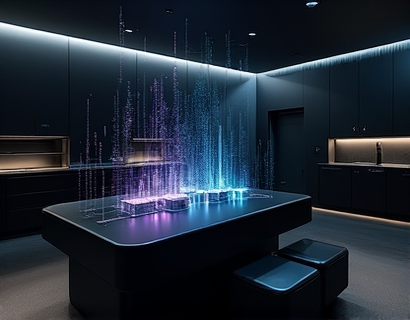Revolutionize Your Live Presentations with Cutting-Edge AI Avatar Technology
In the rapidly evolving landscape of digital communication, businesses and content creators are constantly seeking innovative ways to engage their audiences. One of the most exciting developments in this field is the integration of advanced AI avatar technology into live presentations and virtual events. This technology is not just a novelty; it represents a significant leap forward in real-time interaction and audience engagement. By leveraging lifelike avatars, presenters can captivate their audiences like never before, setting a new standard for digital interactions.
The core of this technology lies in its ability to blend design and advanced artificial intelligence to create dynamic, interactive avatars. These avatars are more than just digital representations; they are sophisticated tools designed to deliver messages with precision and charisma. For businesses and creators, this means an unprecedented opportunity to enhance their presentations, virtual conferences, and online content with a level of engagement that traditional methods cannot match.
Understanding AI Avatar Technology
AI avatar technology utilizes a combination of machine learning, computer vision, and natural language processing to create virtual characters that can mimic human behavior and speech. These avatars are trained on vast datasets to understand and respond to various scenarios, ensuring that their interactions are natural and contextually relevant. The result is a digital presence that can hold a conversation, convey emotions, and even adapt to the audience's reactions in real-time.
The development of these avatars involves several key components. First, 3D modeling and animation techniques are used to create the visual appearance of the avatar. This includes detailed facial expressions, body language, and gestures that contribute to the avatar's lifelike appearance. Next, advanced algorithms process the avatar's speech and movements, allowing it to respond dynamically to the presenter's inputs and the audience's feedback.
Real-Time Interaction and Engagement
One of the most compelling aspects of AI avatar technology is its ability to facilitate real-time interaction during live presentations. Unlike pre-recorded videos or static avatars, these digital characters can engage with the audience on the fly, answering questions, providing additional information, and even handling unexpected situations with grace. This level of interactivity not only keeps the audience more engaged but also makes the presentation feel more personal and authentic.
For example, during a product launch, an AI avatar can field questions from the audience, providing detailed explanations and demonstrations. It can also highlight key features of the product, offer comparisons with competitors, and even gather feedback from attendees. This two-way communication creates a more immersive experience, making the audience feel like active participants rather than passive observers.
Enhancing Presenter Presence
AI avatars can significantly enhance the presence and impact of the presenter. By projecting a digital avatar of the speaker, businesses can overcome geographical barriers, allowing experts from anywhere in the world to participate in events without the need for physical travel. This not only broadens the reach of the presentation but also reduces costs and logistical challenges.
Moreover, the avatar can be customized to reflect the speaker's personality and brand, ensuring consistency in messaging and visual identity. The avatar can adopt different styles and appearances, from formal and professional to more casual and approachable, depending on the context of the presentation. This flexibility allows presenters to tailor their digital presence to better connect with their audience.
Benefits for Businesses and Creators
For businesses, the adoption of AI avatar technology offers numerous advantages. Firstly, it enhances brand visibility and credibility by showcasing cutting-edge innovation. Companies that embrace this technology are perceived as forward-thinking and committed to excellence. Secondly, AI avatars can help in building stronger relationships with customers by providing personalized and engaging interactions. This can lead to higher customer satisfaction and loyalty.
Content creators, including educators, trainers, and entertainers, also stand to gain significantly from this technology. AI avatars can bring educational content to life, making complex subjects more accessible and engaging. In training sessions, avatars can simulate real-world scenarios, providing practical and safe learning experiences. For entertainers, the possibilities are endless, from interactive performances to immersive storytelling.
Technical Implementation and Integration
Implementing AI avatar technology in live presentations requires a robust technical infrastructure. The process begins with the creation of the avatar, which involves 3D modeling, animation, and voice synthesis. The avatar is then integrated with a platform that supports real-time interaction, such as a virtual event software or a live streaming service.
The platform must be capable of handling the computational demands of the avatar, ensuring smooth and lag-free performance. This typically involves high-performance servers, optimized algorithms, and efficient data processing. Additionally, the platform should support various input methods, such as voice commands, gestures, and text inputs, to facilitate seamless interaction.
Case Studies and Success Stories
Several companies and creators have already begun to leverage AI avatar technology with remarkable success. For instance, a major automotive brand used an AI avatar to showcase a new vehicle model at a virtual press conference. The avatar not only presented the car's features but also answered questions from journalists and attendees, providing a comprehensive and engaging experience. The event received widespread praise for its innovation and effectiveness.
In the educational sector, an online learning platform integrated AI avatars to deliver interactive lessons. Students reported higher engagement and better retention of material, attributing this to the avatar's ability to explain concepts in a relatable and dynamic manner. Similarly, a popular podcast series utilized AI avatars to create virtual guests, expanding the range of topics and experts they could feature without the constraints of physical presence.
Future Trends and Developments
The future of AI avatar technology is promising, with ongoing advancements expected to further enhance its capabilities. One area of focus is the improvement of emotional intelligence, enabling avatars to better understand and respond to human emotions. This could lead to even more natural and empathetic interactions, deepening the connection between the avatar and the audience.
Another trend is the integration of augmented reality (AR) and virtual reality (VR) to create fully immersive experiences. Imagine attending a virtual conference where you can interact with AI avatars in a 3D environment, feeling as if they are right there with you. This convergence of technologies will open up new possibilities for remote collaboration, training, and entertainment.
Conclusion
The integration of AI avatar technology into live presentations and virtual events represents a significant leap forward in digital communication. By offering real-time interaction, enhanced presenter presence, and a range of benefits for businesses and creators, this technology is poised to transform the way we engage with audiences. As the technology continues to evolve, the potential for innovative and impactful interactions will only grow, making AI avatars an essential tool for anyone looking to stay ahead in the digital landscape.













